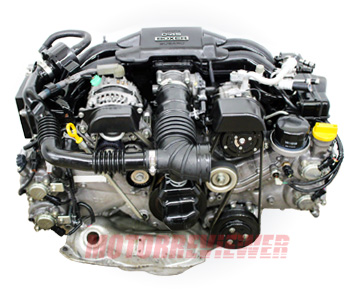Subaru FA20 2.0L Engine Specs, Problems, Reliability, Info

Subaru 2.0L FA20 Info
The Subaru 2.0-liter, four-cylinder, non-turbo engine, FA20, or FA20D, is the result of a joint project between Subaru and Toyota. In Toyota's classification, this engine is called 4U-GSE. Subaru has used the FA20 engine in the first generation of the light and sporty Subaru BRZ coupe model. The Toyota 4U-GSE engine has been used in the Toyota 86 and Scion FR-S models. Let's take a look at what's inside the FA20 and see how it was designed.
FA20/FA20D Engine Overview
First of all, Subaru took the FB20 cylinder block as the basis. The bottom end of the engine has been completely redesigned. The FA20 now has a new crankshaft, connecting rods, and pistons. The engineers created a square engine, meaning that the FA20 has the same bore and stroke dimensions. This gives a bore/stroke ratio of exactly 1:1. Moreover, the compression ratio is higher than that of FB20 — 12.5:1 compared to 10.5:1.
The FA20 has aluminum DOHC cylinder heads with 4 valves per cylinder. The heads are equipped with a variable valve timing system (Subaru AVCS) for both the intake and exhaust camshafts. Camshafts are driven by single roller chains (by one on each side). This engine utilizes some Toyota technologies, specifically the Toyota D-4S combined direct and port fuel injection system. This system features a high-pressure fuel pump, regular injectors and direct injectors located inside the cylinder heads, which inject fuel directly into the combustion chambers. The HP pump is mounted on the left cylinder head, and it is driven by an additional lobe on the intake cam.
The intake system features a plastic intake manifold and a drive-by-wire throttle body. On the exhaust side, it has a high-flow steel 4-2-1 exhaust manifold. As a result, it produces 200 hp at 7,000 rpm and 151 lb-ft, which are really good numbers for a non-turbocharged 2.0-liter engine. However, in 2012, Subaru introduced a turbocharged version of the FA20 engine, called the FA20F (also known as FA20DIT or FA20E). The main goal of the FA20F was to replace the previous 2.0-liter turbocharged EJ205 and EJ207 engines.
Engine Specs
Oil recommendations and capacity may vary depending on the car model, year, and market. Please check the service manual specific to your vehicle!
FA20 Engine Problems and Reliability
For Subaru, it was a new experience with direct fuel injection. For this reason, the early years of production were quite rough. This is a short list of common problems and some disadvantages of the FA20 engine:
- At the start, many owners complained about rough idle and shakes at low RPM. To address this issue, Subaru has made several updates to the ECU.
- In addition, there were some quality issues with certain components: bearings, seals, gears.
- The engine is very dependent on the quality and level of engine oil. Poor oil can cause the rapid wear of camshaft gears and phase adjusters in the AVCS system. A low level of oil can increase the risk of damage to the crankshaft bearings.
- Some of the 2013 Subaru BRZ models were involved in a valve spring recall. The reason for this recall was the possible development of cracks in valve springs.
- The engine requires premium fuel only. Using regular fuel may shorten the lifespan of the injectors and high-pressure pump.
- Another feature of direct injection is the build-up of carbon inside the intake. For preventive purposes, it is advised to clean the intake system every 80-100k miles, for example, using walnut blasting.
Summary
There were some reliability issues at the start, but most of them have since been resolved. The FA20 engine is not an average engine, and it has some unique features that need special attention. It is demanding of maintenance, uses premium fuel and high-quality motor oil. The longevity of Subaru FA20 engine is around 150,000 miles (250,000 km). It is also worth noting that this engine is used in a sports vehicle, which involves active driving. This can significantly affect the lifespan of the engine.
